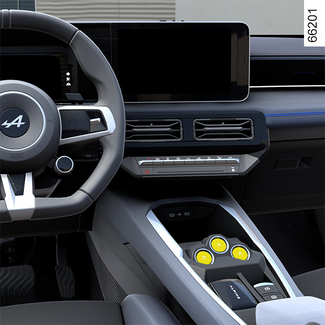Back to the list
Gear control
Gear control
Selection controls

The R, N and D switches can be used to engage various gearbox positions:
- R: reverse;
- N: neutral;
- D: forwards gear.
The engaged position is displayed on the instrument panel as a reminder.
To engage the neutral position (N)
With the vehicle stationary and the engine running, press the brake pedal and briefly
press the N switch (the built-in indicator light on the N switch lights up in white and N is displayed on the instrument panel).
To engage forward gear (D position)
With the vehicle stationary, the engine running and your foot on the brake pedal,
briefly press the D switch (the built-in indicator light on the D switch lights up in white and D is displayed on the instrument panel).
If the brake pedal is not pressed, the current position display flashes for about
five seconds and the "Press brake pedal" message is displayed on the instrument panel for about five seconds.
Note: with D, or R position engaged, if the vehicle is stationary it will move forward as soon as you
release the brake pedal (without pressing on the accelerator pedal).
In most traffic conditions, you will not have to touch the switches.
Note: with the engine running and the vehicle moving at between 0 and 9 mph (14 km/h),
with N or R position engaged, it is not necessary to press the brake pedal to engage D position. This is useful during parking manoeuvres requiring a number of alternate
forward and reverse movements.
To engage reverse gear (R position)
With the vehicle stationary, the engine running and your foot on the brake pedal,
briefly press the R switch (the built-in indicator light on the R switch lights up in white and R is displayed on the instrument panel).
Tip
With D, or R position engaged, if the vehicle is stationary it will move forward as soon as you
release the brake pedal (without pressing the accelerator pedal).
If the brake pedal is not pressed down, the current position flashes for approximately
five seconds and the indicator light 1 remains displayed on the instrument panel.
Note: with the engine running and the vehicle travelling at between approximately 0 and
6 mph (10 km/h), in N or D position, it is not necessary to press the brake pedal to engage R position. This is useful during parking manoeuvres requiring a number of alternate
forward and reverse movements.
Parking the vehicle
With the vehicle stationary, press the brake pedal and briefly press the N switch.
Note: once engaged after the engine is stopped, N position is maintained until the vehicle ignition is switched on again.
Ensure that the parking brake is engaged and that the vehicle is immobilised .
WARNING
The electronic parking brake can be used to immobilise the vehicle. Before leaving
the vehicle, check that the electronic parking brake is fully applied. The application
of the electronic parking brake is confirmed by the illumination of the indicator
light on the electronic parking brake switch and the  warning light on the instrument panel until the doors are locked. Depending on the
vehicle, a label is affixed at the top of the windscreen as a reminder of this .
warning light on the instrument panel until the doors are locked. Depending on the
vehicle, a label is affixed at the top of the windscreen as a reminder of this .
WARNING
Engaging the gear control N position does not mechanically lock the drive wheels: ensure that the vehicle is
immobilised before leaving the vehicle.
WARNING
For safety reasons, do not switch off the ignition before the vehicle has come to
a complete standstill.
Operating faults
In the event of an engine fault or an electrical fault (battery fault, etc.), make
sure that the vehicle is properly immobilised.
WARNING
An impact to the underside of the vehicle while manoeuvring (e.g. striking a post,
raised kerb or other street furniture) may result in damage to the vehicle (e.g. deformation
of an axle).
To avoid any risk of accident, have your vehicle checked by an approved dealer.
